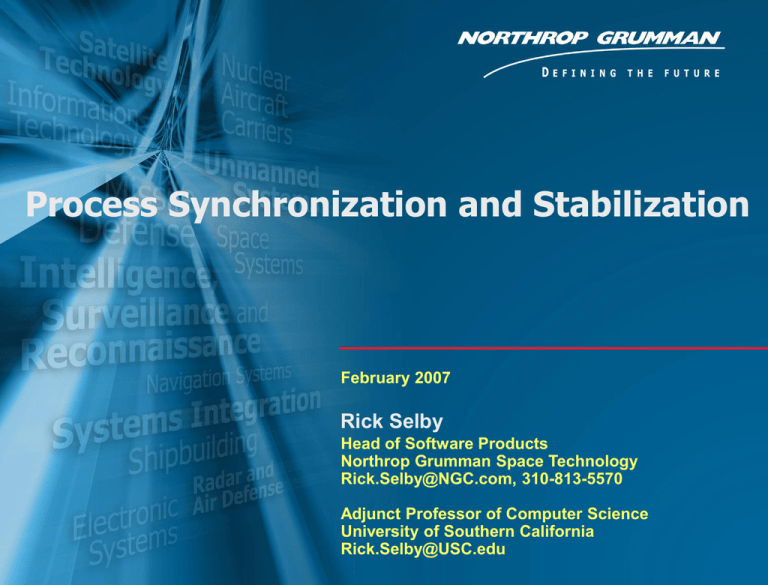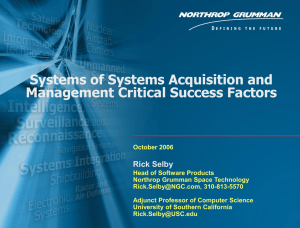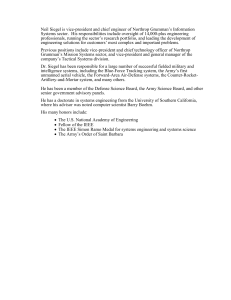
Process Synchronization and Stabilization
February 2007
Rick Selby
Head of Software Products
Northrop Grumman Space Technology
Rick.Selby@NGC.com, 310-813-5570
Adjunct Professor of Computer Science
University of Southern California
Rick.Selby@USC.edu
0
© Copyright 2007. Richard W. Selby and Northrop Grumman Corporation. All rights reserved.
“Process Owners” Define, Monitor, and Improve
Products & Processes Using Metric-Driven Analyses
What do managers control at different levels of an
organization?
Executives – Define, monitor, and improve:
Vision, values, high-level policies, financial, etc.
“Process owners” – Define, monitor, and improve:
Processes using metric-driven analyses to improve
products and services
Project managers (or “product owners”) – Define,
monitor, and improve:
Products and services
1
© Copyright 2007. Richard W. Selby and Northrop Grumman Corporation. All rights reserved.
Six Sigma Projects Decrease Process or Product
Defects by Reducing Variances and Shifting Means
Six Sigma projects typically focus on decreasing process or product nonconformances (“defects”) through reducing variances and shifting means of
process performance or product quality metrics
Projects decrease the variability of process performance or product quality
metrics to improve predictability (such as smaller gaps in plans vs. actuals),
efficiency (such as shorter cycletimes), and effectiveness (such as fewer defects)
Six Sigma gets it name because it states a goal of achieving no worse than 3.4
defects per million opportunities, which is six process sigma (roughly analogous
to standard deviations) from the mean (99.9997% accuracy)
Commonly use DMAIC approach: Define, Measure, Analyze, Improve, and Control
2
© Copyright 2007. Richard W. Selby and Northrop Grumman Corporation. All rights reserved.
Control Charts Identify Behavior Outside of
Expected Control Limit Boundaries
Exception process
variation
Exception process
variation
Upper
Control
Limit
Project XYZ
(Defect Density for Process X)
Process
Average
Lower
Control
Limit
Actual Performance
Data from Project XYZ
3
© Copyright 2007. Richard W. Selby and Northrop Grumman Corporation. All rights reserved.
Control Limits Define “Voice of the Process” and
Specification Limits Define “Voice of the Customer”
USL
UCL
LCL
LSL
Control limits represent “voice of the process”: Upper control limit (UCL)
and lower control limit (LCL)
Derived statistically using process or product data
Help determine whether the process is stable
Specification limits represent “voice of the customer”: Upper
specification limit (USL) and lower specification limit (LSL)
Represent goals, requirements, or targets
Help determine whether the process is capable
4
© Copyright 2007. Richard W. Selby and Northrop Grumman Corporation. All rights reserved.
Data-Driven Statistical Analyses Identify Trends,
Outliers, and Process Improvements for Defects
• Six Sigma Project Introduced
New Peer Review Process
• Provided Training on Process
• New Web-Based Peer Review
Tool
• Provided Training on Tool
These defects are action items
resulting from peer reviews of
software code and unit testing
plans and results.
Control chart of metric data from example Six Sigma projects focusing on
fault (or defect) density in peer reviews of software components
5
Data from 10 systems
© Copyright 2007. Richard W. Selby and Northrop Grumman Corporation. All rights reserved.
Data-Driven Statistical Analyses Identify Trends,
Outliers, and Process Improvements for Cycletimes
• Web-based tracking tool
deployed
• Action tracking process
started
I Chart for Action Item
Closure Performance
1
300
1 1
All actions are from SW
Requirements Reviews.
1
100
11
1 11111111
1 11111
-100
1
Negative values indicate
actions closed before their due
date.
1
1
-200
1
1
1
0
100
9/
UCL=1.631
Positive values indicate
Mean=-19.71
actions closed after their due
LCL=-41.05date.
11111
1
1
Chart plots deltas between
action item due date and
closure date.
Limit
1 11 1Spec
1
0
open
date
Specification limit defines goal
for action item cycletime
closure.
1
200
Days Past Due
actions opened
after April 1, 2004
/2
30
200
3
00
2/
0
20
3/
300
4
3
2
6/
/2
400
4
00
5/
20
4/
500
Two-sample t-test confirms
that data after April 1, 2004 is
statistically different than data
preceding this date (α < 0.05)
04
Control chart of metric data from example Six Sigma projects focusing on
action item closure cycletime in peer reviews of software components
6
Data from one system
© Copyright 2007. Richard W. Selby and Northrop Grumman Corporation. All rights reserved.
Data-Driven Statistical Analyses Identify Trends,
Outliers, and Process Improvements for Cycletimes
• Series of process
improvements instituted and
new control limits calculated
Statistically significant
improvement in process
performance
Control chart of metric data from example Six Sigma projects focusing on
change request closure cycletime for software components
7
Data from one system
© Copyright 2007. Richard W. Selby and Northrop Grumman Corporation. All rights reserved.
Synchronize-and-Stabilize Timeline and Milestones:
12-36 Months from “Milestone 0” to Manufacturing
Phases
Timeline
Milestones
Major
Reviews
Documents and
Intermediate
Activities
Milestone 0
Vis ion statemen t
Specification documen t
Planning
3-12 months
6-10 weeks
• Cod e and optimizations
• Testin g and d ebu ggin g
• Featu re s tab ilization
Sched ule
co mp lete
Subproject I
Project plan
approval
Subproject II
2-5 weeks
• Integration
• Testin g and d ebu ggin g
6-16 months
Development
Development
6-12 months
2-5 weeks
• Buffer time
Subproject III
Development
Subproject
2-4 month s
(1/3 of all features)
Specificatio n
review
Implementation plan
Milesto ne II
release
Milesto ne III
release
Vis ual freeze
Code complete
Stabilization
3-8 months
Project
review
Milesto ne I
release
Feature complete
Optimizations
Tes ting an d debug ging
Optimizations
Tes ting an d debug ging
Internal tes ting
Buffer time
Beta testin g
Buffer time
Zero bug release
Releas e to
manufacturing
(Ship date)
8
Proto types
Des ign feasib ility stu dies
Tes ting strateg y
Sched ule
Pos tmortem
documen t
© Copyright 2007. Richard W. Selby and Northrop Grumman Corporation. All rights reserved.
Incremental Software Builds Deliver Early
Capabilities and Accelerate Integration and Test
Figure 4.3-4. JIMO Incremental Software Builds
We provide incremental software deliveries support integration and test activities and synchronize with JPL,
Hamilton Sundstrand, and Naval Reactors to facilitate teaming, reduce risk, and enhance mission assurance.
CY 2004 2005
2006
2007
2008
2009
2010
A
B
C
ATP
PMSR
SM PDR
SM CDR
11/04
1/05
6/08
8/10
Flight Computer Unit (FCU) Builds
P
FCU1
Prelim Exec and C&DH Software
P
FCU2
2011
2012
2013
D
BUS I&T SM AI&T
8/12
8/13
JPL/NGC, Prelim.
Hardware/Software
Integration
JPL/NGC, Final Hardware
/Software Integration
JPL, Mission Module
Integration
Final Exec and C&DH Software
P
FCU3 Science Computer Interface
P
FCU4
Power Controller Interface
Reactor
AACS (includes autonomous navigation) P FCU5
Thermal and Power Control
P
FCU6
Configuration and Fault Protection
P
FCU7
Science Computer Unit (SCU) Builds
Note: Science Computer builds for common software only (no instrument software included)
Prelim Exec and C&DH Software
SCU1
SCU2
Final Exec and C&DH Software
Data Server Unit (DSU) Builds
DSU1
Prelim Exec and C&DH Software
DSU2
Final Exec and C&DH Software
P DSU3 Data Server Unique Software
Ground Analysis Software (GAS) Computer Builds
P
Preliminary Ground Analysis Software GAS1
Final Ground Analysis Software GAS2
Legend:
=
1
2
3
4
5
=
1
2
3
4
5
=
1
2
3
4
5
N
Design Agent
Performer of Activity N
JPL
P
Prototype
NGC
Role/activity shared by Activity
JPL and NGC
Delivered to, Usage
Power Controller
NR, Reactor
Integration
NGC, AACS Validation on
SMTB
NGC, TCS/EPS
Validation on SSTB
NGC, Fault Protection S/W
Validation on SSTB
JPL, Prelim.
Hardware/Software
Integration
JPL, Final Hardware/
Software Integration
NGC, Prelim. Hardware/
Software Integration
NGC, Final Hardware/
Software Integration
NGC, HCR Integration on
SMTB
JPL, Prelim. Integration
into Ground System
JPL, Final Integration into
Ground System
N is defined as follows:
1 Requirements
2 Preliminary Design
3 Detailed Design
4 Code and Unit Test/Software
Integration
5 Verification and Validation
04S01176-4-108f_154
9
© Copyright 2007. Richard W. Selby and Northrop Grumman Corporation. All rights reserved.
Analyses of Software Defect Injection and
Detection Phases Reveals Distributions and Gaps
Software Defect Injection and Detection Phases
Defects Injected (cumul. %)
Defects Detected (cumul. %)
100.0%
Defects (cumul. %)
90.0%
80.0%
70.0%
60.0%
50.0%
40.0%
30.0%
20.0%
10.0%
e
U
ni
In
tT
te
es
gr
t
at
io
n
SW
Te
st
V
er
ifi
ca
Su
tio
pp
n
or
tt
o
I&
M
T
ai
nt
en
an
ce
O
pe
ra
tio
ns
C
od
SW
Ex
t
er
Pr
op
na
os
lR
al
eq
.S
ou
R
rc
eq
e
u
Pr
ire
el
m
im
en
in
ts
ar
y
D
D
es
et
ig
ai
n
le
d
D
es
ig
n
0.0%
System Development Phase
Cumulative distribution of software defect injection and detection phases
based on using peer reviews across 12 system development phases
3418 defects, 731 peer reviews, 14 systems, 2.67 years
10
© Copyright 2007. Richard W. Selby and Northrop Grumman Corporation. All rights reserved.
Analyses of Software Requirements Shows Leading
Indicators for Implementation Scope
Ratio of Implementation Size to Requirements
Size / Requirements
Average (ex. #14)
Average + 2 std. (ex. #14)
550
Source-Lines-of-Code /
Requirements
500
450
400
350
300
250
200
150
100
50
0
1
2
3
4
5
6
7
8
9
10
11
12
13
14
System
Data from 14 NASA systems
Ratio of implementation size to software requirements has 81:1 average and 35:1
median; Excluding system #14, the ratio has 46:1 average and 33:1 median
Ratio of software requirements to system requirements has 6:1 average
11
© Copyright 2007. Richard W. Selby and Northrop Grumman Corporation. All rights reserved.
Five-Phase Process Defines Structured Approach
for Six Sigma Improvement Projects
Phase
Define
Measure
Analyze
Improve
Control
Exit Criteria
Duration
Project scope defined, business case established, and
stakeholders engaged
Metrics defined, data collected, and data validated
5 weeks
3 weeks
3 weeks
Processes and products analyzed, root cause analyses
completed, and sources of variation understood
Potential solutions identified, recommended solution
5 weeks
piloted, and improvements documented using data
Ongoing monitoring using statistical methods such as
Ongoing
control charts, supported by special cause and common
cause analysis of violations of control limits and
specification limits
Total
16 weeks +
Control Phase
Six Sigma implementation approach can span 16
weeks and include tollgate reviews for define,
measure, analyze, improve, and control phases
Tollgate reviews provide checkpoints for progress,
evaluation, and feedback
12
© Copyright 2007. Richard W. Selby and Northrop Grumman Corporation. All rights reserved.
Synergistic Strategies Help Enable Large-Scale
Software System Development and Management
Analysis
Infrastructure and
techniques for system
modeling, analysis, and
simulation
Modeling
Infrastructure &
Techniques
Evaluations &
Feedback
System modeling,
evaluation, tradeoff, and
prediction using
simulations and empirical
studies
Analysis
Capabilities
Processes &
Architectures
13
Requirements &
Opportunities
Synthesis
Flexible lifecycle process
models, extensible
system architectures, and
pro-active development
guidance mechanisms
Models,
Relationships &
Feedback
Research focus: Large-scale, mission-critical embedded software systems
Research themes: Early lifecycle, system perspective, frequent design cycles,
multi-artifact integration, scalable modelware
© Copyright 2007. Richard W. Selby and Northrop Grumman Corporation. All rights reserved.








